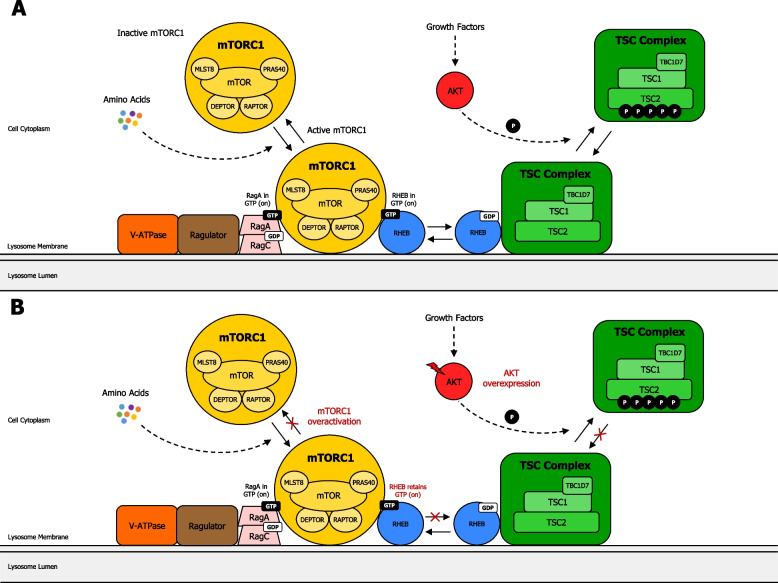Fig. 5.
Regulation of mTORC1 through the TSC complex. A Regulation of mTORC1 through the TSC complex in normal cells. The signal integration model of mTORC1 is regulated by growth factors and amino acids. Rag heterodimer (RagA and RagC) interacts with Ragulator and V-ATPase on the lysosome membrane. Amino acids then allow connection of mTORC1 to Rag heterodimer/Ragulator/V-ATPase complex. The TSC complex maintains Rheb in the GDP-bound state. Growth factor-induced AKT phosphorylates TSC2, leading to dissociation from the lysosomal membrane, promoting Rheb to become GTP loaded, and thus, activating mTORC1. B Regulation of mTORC1 through the TSC complex in cancer cells. Mutations in AKT or upstream genes in the PAM pathway, can potentially lead to overactivation of mTORC1, due to TSC complex being released from Rheb. Consequently, Rheb becomes GTP loaded, resulting in activation of mTORC1, recruited by Rag proteins. This dysregulation may promote the onset and/or progress of cancer, resulting in enhanced cell survival, proliferation, growth, and metabolism in cancer cells. Activation of mTORC1 potentially sends critical signals that engender tumor cells to metastasize and invade new tissues. mTORC1: mechanistic target of rapamycin complex 1; DEPTOR: DEP domain-containing mTOR-interacting protein; MLST8: mammalian lethal with SEC13 protein 8; PRAS40: proline-rich AKT1 substrate 1; RAPTOR: regulatory-associated protein of mTOR; RHEB: Ras homolog enriched in brain; TBC1D7: TBC1 Domain Family Member 7; TSC2: tuberous sclerosis complex 2. Activation (phosphorylation or non-phosphorylation) is shown with arrowhead lines or dotted-arrowhead lines. Red lightning symbol shows mutation for a particular gene in the PAM pathway. Red crosses emphasise signaling blockage. P: phosphoryl group

